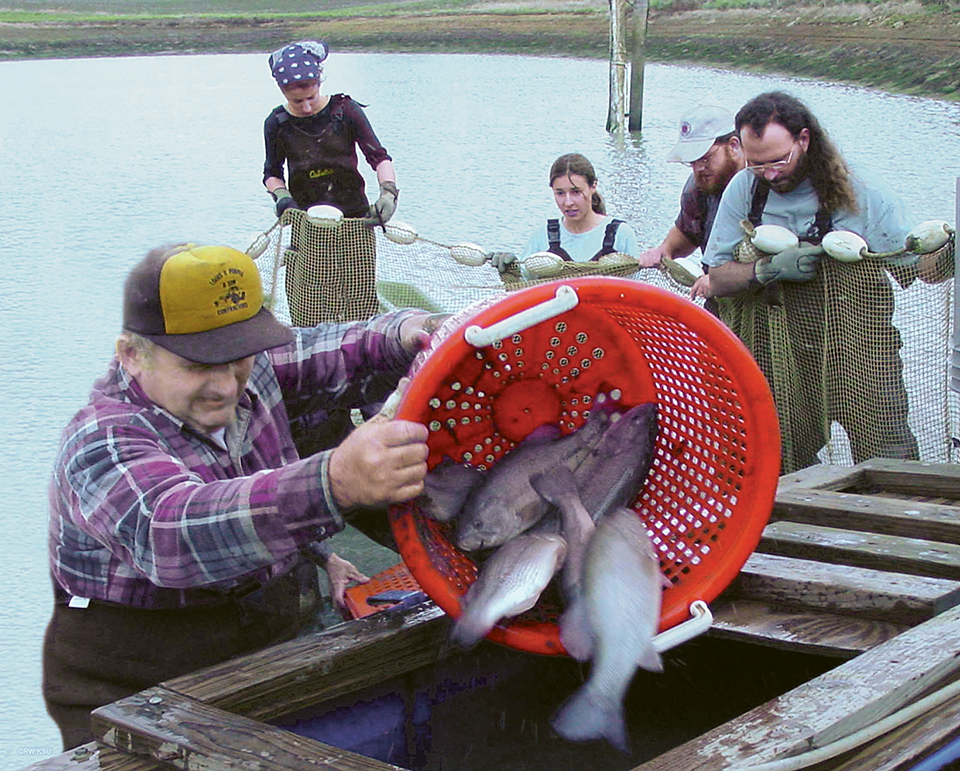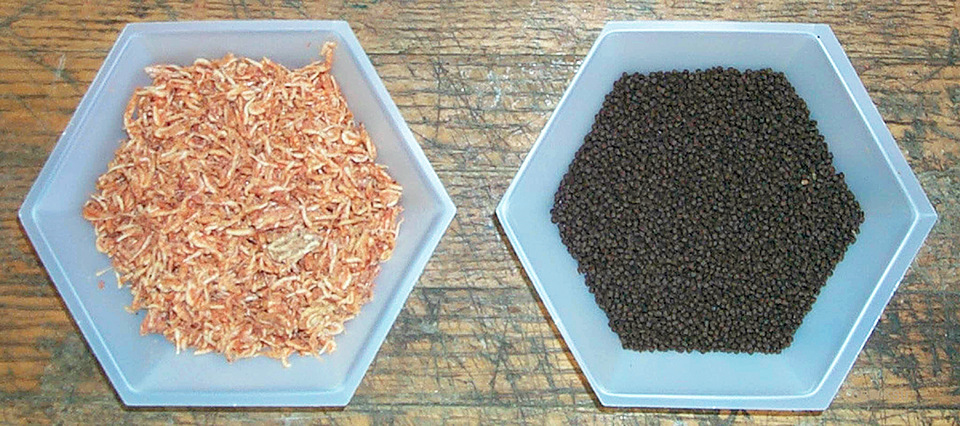Sport fish, stocker fish, food fish

The largemouth bass (Micropterus salmoides) is a member of the sunfish (Centrarchidae) family. Members of the genus Micropterus are known as black bass, and share the sunfish family with bream, crappies, and several other genera.
Largemouth bass are native to the Midwestern and southeastern United States and northeastern Mexico. They have been introduced throughout the U.S. and many other countries worldwide.
Interest in the commercial culture of largemouth bass is due to great demand and a high selling price compared to other cultured species. The largemouth bass is also one of the most popular sport fish in the United States.
Although there has been extensive research on the hatchery production and fisheries management of largemouth bass, amazingly little study has been conducted on the growth of bass to larger sizes, their nutritional requirements, and suitability as an aquaculture species.
Research and remedial stocking
In the 1960s, Dr. Jack Snow conducted a series of studies at Auburn University in Alabama, USA, on raising largemouth on feed to sizes of about 15 to 20 cm as a method of increasing and intensifying hatchery production for sport fish stocking. During the 1980s, federal and state hatcheries refined feed-training techniques, again to maximize hatchery production.
In recent years, aquaculturists have become interested in the culture of largemouth to larger sizes. This interest is based on an increasing demand for large bass for remedial stocking in sport fish ponds, their use in commercial “trophy” lakes, and as a food fish among ethnic Asians.
Fry production

The production of largemouth bass fry follows well-established procedures that date back to the 1930s. Largemouth are usually pond-spawned and do not require hormone or photoperiod manipulations. At 2 years of age or older, broodfish of about 0.68 kilograms in weight are stocked into 0.2- to 0.4-ha spawning ponds at 125 brood pair per hectare.
Broods can be stocked when temperatures reach 18.3 degrees-C, and spawning should begin soon after. Ponds must be free of existing fish. Spawning ponds are normally not fertilized, so that spawning behavior, eggs, and fry can be easily observed and harvested.
Nursery ponds
Nursery ponds should be prepared as soon as spawning begins using organic and inorganic fertilization to produce large numbers of zooplankton for the bass fry. When large numbers of fry are seen in a spawning pond, they should be transferred to a nursery pond and stocked at about 100,000 to 200,000 fry per hectare. After three or four weeks in a properly prepared nursery pond, bass fingerlings should reach 3.8 to 5.1 cm in length and be ready for feed training.
Feed training
To feed train largemouth bass, the basic concept is to remove the fish from the natural source of food, crowd them at high densities, and present them with highly palatable prepared foods at frequent and regular intervals. For feed training, fingerlings are seined from the nursery pond, graded to uniform sizes, and stocked in flow-through tanks at a high density based on water flow. Fish are then offered freeze-dried krill, ground fish flesh, or fish eggs. Freeze-dried krill is especially effective, commercially available, and easy to feed and store.
These highly palatable products are then gradually mixed with a high-quality salmonid diet. Over a week, each day’s feed ration should be increasingly comprised of the manufactured feed. By day 7, the fish should consume straight feed.
Fish trained to take the feed become thick-bodied, with large bellies. They can be removed with graders, moved to a separate tank or small pond, and maintained on feed for several more days before pond stocking. Fish that obviously haven’t trained can be left in the tank for repeated applications of moist training diets or krill. After an additional week, most of these fish adapt to the feed diet.
With good results, about 80 to 90 percent of the fish originally stocked should train to accept artificial diets. Recent studies have shown that offspring from second- or third-generation feed-trained fish train more easily than those with relatives that don’t take to feed.
Fish care
During the training period, tanks should be cleaned daily, with water quality maintained by suitable flow. Because of the crowded conditions and large amounts of feed used, external parasites can be a problem, as can columnaris. Diagnose and treat affected fish quickly and properly.
Terramycin has been used to effectively treat columnaris by inclusion in feed-training diets. A 0.5 or 1.0 percent salt bath for up to one hour is effective in reducing stress when handling and grading, and also reduces the occurrence of infectious disease. Also, 15 to 25 ppm formalin plus potassium per-manganate has been used with mixed results.
Transfer to ponds
After the fish feed actively for at least two weeks, they can be stocked into ponds at 50,000 to 75,000 animals per hectare and fed two or three times daily using a 40- to 80 percent-protein salmonid diet with 8 to 10 percent fat. Feed the fish all they readily consume at each feeding.
Largemouth feed voraciously on some days and not so actively on others. This is probably associated with temperature, sunlight, and/or water quality changes. Feeding at dawn and/or dusk may be advantageous due to the lower light levels. A floating diet is desirable, as it allows the person feeding to more easily observe the fish as they approach satiation.
Bass should attain sizes of 15 to 20 cm, with some larger individuals, by the following fall. This size, which is well suited to pond stocking, brings approximately U.S. $0.75 per fish wholesale and $1.50 per fish retail.
Producing larger fish
One additional year of growth is required to produce fish of 0.45 kg or greater. Fish can be thinned to grow-out densities in the fall or spring. However, fish should not be handled when water temperatures are below 12.8 degrees-C, due to possible fungal infections.
Some authors have recommended a grow-out density of 4,942 per hectare for largemouth bass. However, research at Kentucky State University in Frankfort, Kentucky, USA, found no difference in the average weights of fish stocked at 6,170 to 12,355 bass per hectare, while the higher density produced double the amount of fish per unit of pond.
Additional research at Kentucky State found production was best when bass were stocked at 12,355 to 14,826 per hectare and fed a 46 to 48 percent-protein diet with 6 to 8 percent lipid. Fish fed once daily to satiation produced approximately 5,040 kilogram per hectare of fish that averaged about 408 grams.
Bass can be harvested by seine, a method also used to harvest catfish. Bass are actually easier to catch, but jump over the seine if its edges aren’t held high.
Water quality
Water quality tolerances in largemouth bass vary with age and other culture conditions. Feed-conversion efficiencies fall at oxygen concentrations below 4 milligrams per liter, but the fish can tolerate a dissolved-oxygen level of 1.4 milligrams per liter at 25 degrees-C for short periods of time.
Ammonia tolerance is similar to or slightly less than channel catfish, with a 24-hour unionized ammonia LC50 value of 1.69 milligrams per liter. However, centrachids appear to be very tolerant of high nitrite concentrations due to an ability to prevent absorption. The 96-hour LC50 for nitrite is 24.8 milligrams per liter in channel catfish, but 460 milligrams per liter in largemouth bass.
Nutritional information

Nutritional knowledge on largemouth bass is extremely limited. In the 1960s, Snow successfully fed the “Oregon moist pellet” formulated for salmonids to juvenile bass to a size of about 20 cm. In the 1980s, studies determined a protein requirement of 41 percent for year-old fish. Pond studies raising second-year fish to approximately 0.340 kg demonstrated that diets containing 42 to 48 percent protein could be advantageous. Most largemouth bass in commercial production are currently fed salmonid diets of greater than 40 percent protein based primarily on availability.
However, reported problems concerning pale, fatty livers and mortality have been thought to be nutritionally related. Liver problems may reflect a skewed protein per energy ratio or excess carbohydrates in the diet. Winter mortality in pellet-fed fish could also be related to nutrition. Additional nutritional research is sorely needed as an essential component to the development of efficient aquaculture production of this fish.
Diseases
Largemouth are susceptible to many of the parasites and bacterial diseases common to most cultured fish. Diseases specific to the largemouth bass are not common, although there are recent reports of a largemouth bass virus. The best way to avoid disease problems is to minimize handling during the summer and winter. Like other sunfish, largemouth are very susceptible to columnaris disease, especially during the training period. Bass are also prone to fungal infections when handled at temperatures below 12.3 degrees-C, and mortalities can be extremely high.
Asian markets
Consumers in Asia desire live largemouth bass above all other freshwater fish. They prefer fish of 0.68 to 0.90 kg, which may require a third year of grow-out. A study at KSU showed relatively slow third-year growth, however, as fish only went from 408 to 555 grams during the third summer. Interestingly, the fish grew better at high densities.
Production methods for sizes greater than 0.45 kg should be investigated further, as demand for fish of this size has been identified in excess of 317,460 kilograms per year at over U.S. $6.62 per kilogram live weight.

Processing
Processing of largemouth has not been reported. However, bass tend to have a relatively round body profile, and can become quite thick in body confirmation at large sizes. Preliminary data from KSU indicated dress-out values of 60 percent whole dress, 40 percent fillet, which is similar to catfish.
The bass have relatively high protein levels and extremely high levels of omega-3 fatty acids. These are the “heart-healthy” fatty acids reported to be advantageous for human health.
(Editor’s Note: This article was originally published in the August 2003 print edition of the Global Aquaculture Advocate.)
Now that you've finished reading the article ...
… we hope you’ll consider supporting our mission to document the evolution of the global aquaculture industry and share our vast network of contributors’ expansive knowledge every week.
By becoming a Global Seafood Alliance member, you’re ensuring that all of the pre-competitive work we do through member benefits, resources and events can continue. Individual membership costs just $50 a year. GSA individual and corporate members receive complimentary access to a series of GOAL virtual events beginning in April. Join now.
Not a GSA member? Join us.
Authors
-
James H. Tidwell, Ph.D.
Aquaculture Research Center
Kentucky State University
Frankfort, Kentucky 40601 USA -
Shawn D. Coyle
Aquaculture Research Center
Kentucky State University
Frankfort, Kentucky 40601 USA
Tagged With
Related Posts

Aquafeeds
Largemouth bass responses to supplemental EPA, DHA
This 10-week feeding trial aimed at complementing existing information on largemouth bass responses to oils with supplemental EPA and DHA. Dietary supplementation of these essential fatty acids may be required in feeds for this species.

Health & Welfare
Feeds, feeding methods advance for largemouth bass
U.S. demand continues for largemouth bass in sport fish stocking and live markets, whereas Asian consumers prefer live largemouth over most freshwater fish.

Health & Welfare
Biomass density affects bass production
The production period for largemouth bass in ponds hampers the economic feasibility of pond culture in the United States. A study demonstrated that bass fingerlings could be raised at high densities in a semi-closed recirculating system without serious mortality, size variability or growth retardation.


